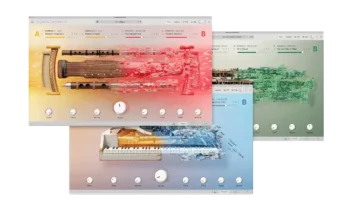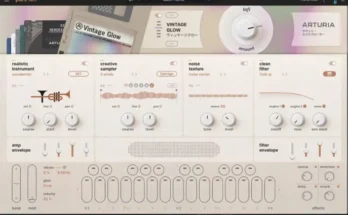AU/VST/VST3/AAX | 19 November 2019 | 242 MB
From its broadcast origins to its use on some of the best-selling, most enduring records of all time, the V76 preamp has played a pivotal supporting role in the story of pop music.
Loved by the engineers and technicians at Abbey Road, and incorporated into their iconic REDD mixing consoles, the V76 coveted for that “White Album” sound, every major studio in the world wanted a piece of the action, and tens of thousands of Telefunken preamps were created to meet the demand.
These days, due to scarcity and cost, it’s practically impossible for most musicians and producers to pick up one of these legendary preamps. In the same way Arturia built its reputation on recreating legendary, rare synths and keyboards through advanced modelling, we decided to use our TAE® technology to give everyone the chance to experience that legendary V76 sound.
Vintage sound with today’s technology
… how does a software preamp work? My audio interface already has preamps, what difference will it make?
Simply put, preamps were originally created to make signals louder. They would take a low-powered audio signal – from a microphone or instrument, for example – and amplify them so that they were the strong enough for mixing, while minimizing any added noise. North West German Radio were early pioneers of this technology, creating high quality preamps for broadcasting. Enhancing NWGR’s design, Telefunken produced the V72, which later evolved into the studio-focused V76, and became a staple in studios around the world.
Fast forward 70 years, and the pro audio industry has changed a little. Superbly transparent, low noise, affordable preamps are included in almost every audio interface. However, the subtle tonal shift that vintage preamps gave to the audio they treated, especially vacuum-tube designs like the V76, are missing today.
We wanted to give you the best of both worlds: the ability to color the sound of your modern recorded audio and virtual instruments with the iconic tone of classic studio gear.
Adding that “je ne sais quoi”
It’s difficult to let new producers and mix engineers know just how important the subtle sound-shaping power of preamps are, we’re talking about something understated. It’s not a flashy synth or an extreme audio-mangling plug-in.
At their core, all of our preamp plugins provide 2 main benefits:
A link to the past
There’s something quite magical about hearing classic songs. If you let your mind drift, you’re transported to a totally different time: different fashion, different politics, different tastes, different lives. If you’re after “that” 60’s sound, you can’t go far wrong with V76-Pre. Added to individual tracks in your song, you can get that tonal push and lush soft-clipping that comes with valve-driven vintage electronics.
Mixing confidence
Load up V76-Pre as an “insert” effect on a channel, dial in an appropriate preset, and most of the hard work has been taken care of. You’ll now be mixing with the sound of a classic analog console, with the parameters set up by a top sound designer. Now you’re free to get creative, safe in the knowledge that you have over half a century of legendary pro audio heritage supporting you.
Its rich tone and huge creative potential made it an integral part of Abbey Road’s setup at arguably the most pivotal point in their history. Despite being known as the go-to microphone preamp for radio broadcast and studio use, and first-choice mastering amplifier, working V76 units are hard to come by. Fortunately for us, we were able to start and end our quest for ultimate tube-tone in France.
At Question De Son, a highly-esteemed recording studio in Paris’ 10th arrondissement, we were able to study an original, sequential pair of V76/80 preamps. Models 4754 had 4755 have been in active service for 70 years, and made the perfect subjects for our study.
We didn’t just want to create a carbon copy, but rather give you the best elements of Telefunken’s sonic signature. For example, made the gain controls continuous for more precise control, removed the seldom-used “broadcast utility” 3kHz low-pass switch, and refined the boost and cut range of the V612 EQ, giving you studio tools that are more usable for the modern musician.
Thanks to the tireless efforts of Arturia’s research, modelling, and development teams, you too can include the tone of the fabled V76 preamp and V612 equalizer into your DAW setup.
Take a closer look
The V76-Pre combines the finest German-designed preamp and EQ of the era into one amazing vintage channel strip plugin. Let’s take a look at what makes it such a joy to use.
Modified V612 2-band Equalizer
V76-Pre’s equalizer is modelled on a rare, modified Telefunken V612, giving you access to a musically-placed high shelf and low shelf. These can both be cut or boosted by 10dB for subtle balancing of your signal.
V76 Input Gain
The main control of the preamp, letting you increase the strength of the incoming signal, passing it through the virtual circuitry and vacuum tube. It starts to impart more of its tonal flavor the hotter the signal gets, until it starts to break up with harmonically rich soft-clipping.
Multi-mode Low-Pass Filter
The included low-pass lets you remove low bass frequencies at 80Hz, roll off the high-energy low end at 300Hz, or use both together to create a more dramatic effect. The low-pass can also be bypassed, leaving your signal unfiltered.
Output Trim
Simple, but always useful. The output trim lets you adjust the “master volume” of the output by 24dB without changing its tone.
Mid/Side mode
Absent from the Telefunken original, V76-Pre lets you use advanced mid/side techniques without external processing or convertors, meaning your audio will sound amazing in both mono and stereo.
Release Notes – 1.1.0.388
New Features:
NKS compatibility
Control knob with mouse scroll
Added maximize height button
Minor browser improvements
Bugfixes FX Collection:
No more crash on old CPUs
No more crash when removing the plugin from a track in FL Studio 20 on macOs
Favorites are now recalled correctly
Cubase bypass function now works properly
Faders and encoders now stop moving after your release them in Reason
No more delay when moving a linked parameter
VU meter calibration is now properly recalled in DAWs
No more issue when automating toggle parameters in AAX
Simpler crack = faster loading time compared to Hexwars release
[toggle title=”Home page”]https://tinyurl.com/qndug64[/toggle]

http://alfalink.to/c960f4d46e293a26f409
Please REPORT in Comment Broken Links




